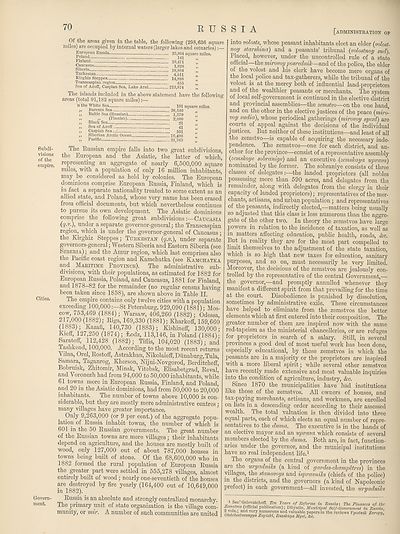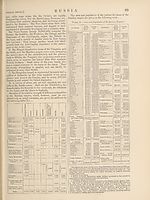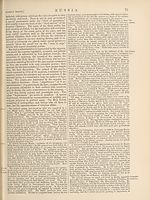Encyclopaedia Britannica > Volume 21, ROT-Siam
(80) Page 70
Download files
Complete book:
Individual page:
Thumbnail gallery: Grid view | List view

70
K U S S I A
[administration op
Subdi¬
visions
of the
empire.
Cities.
Govern¬
ment.
Of the areas given in the table, the following (298,636 square
miles) are occupied by internal waters (larger lakes and estuaries)
European Russia 25,804 square miles.
Poland 141
Finland 18 471
Caucasus 1628
Siberia 18’864
Turkestan 4,511
Kirghiz Steppes 14,888
Transcaspian region 455
Sea of Azoff, Caspian Sea, Lake Aral 213,874
The islands included in the above statement have the following
areas (total 91,182 square miles):—
11 the White Sea 191 square miles.
Barents Sea 35 540
Baltic Sea (Russian)., l’579 ”,
„ (Finnish) 2*000 ”
Black Sea 21
Sea of Azoff.. 41 ”
Caspian Sea..; 551 "
Siberian Arctic Ocean 16,496 ”
Pacific 3L763 ”
The Russian empire falls into two great subdivisions,
the European and the Asiatic, the latter of which,
representing an aggregate of nearly 6,500,000 square
miles, with a population of only 16 million inhabitants,
may be considered as held by colonies. The European
dominions comprise European Russia, Finland, which is
in .fact a separate nationality treated to some extent as an
allied state, and Poland, whose very name has been erased
from official documents, but which nevertheless continues
to pursue its own development. The Asiatic dominions
comprise the following great subdivisions:—Caucasia
(q.v.), under a separate governor-general; the Transcaspian
region, which is under the governor-general of Caucasus;
the Kirghiz Steppes; Turkestan (q.v.), under separate
governors-general; Western Siberia and Eastern Siberia (see
Siberia) ; and the Amur region, which last comprises also
the Pacific coast region and Kamchatka (see Kamchatka
and Maritime Province). The administrative sub¬
divisions, with their populations, as estimated for 1882 for
European Russia, Poland, and Caucasus, 1881 for Finland,
and 1878—82 for the remainder (no regular census having
been taken since 1858), are shown above in Table II.
The empire contains only twelve cities with a population
exceeding 100,000:—St Petersburg, 929,090 (1881); Mos¬
cow, 753,469 (1884); Warsaw, 406,260 (1882) ; Odessa,
217,000 (1882); Riga, 169,330 (1881); Kharkoff, 159,660
(1883); Kazan, 140,730 (1883); Kishineff, 130,000;
Kieff, 127,250 (1874); Eodz, 113,146, in Poland (1884);
Saratoff, 112,428 (1882); Tiflis, 104,020 (1883); and
Tashkend, 100,000. According to the most recent returns
Vilna, Orel, Rostoff, Astrakhan, Nikolaieff, Dunaburg, Tula,
Samara, Taganrog, Kherson, Nijni-Kovgorod, Berditcheff,
Bobruisk, Zhitomir, Minsk, Vitebsk, Elisabetgrad, Reval,
and Voronezh had from 94,000 to 50,000 inhabitants, while
61 towns more in European Russia, Finland, and Poland,
and 20 in the Asiatic dominions, had from 50,000 to 20,000
inhabitants. The number of towns above 10,000 is con¬
siderable, but they are mostly mere administrative centres;
many villages have greater importance.
Only 9,263,000 (or 9 per cent.) of the aggregate popu¬
lation of Russia inhabit towns, the number of which is
601 in the 50 Russian governments. The great number
of the Russian towns are mere villages; their inhabitants
depend on agriculture, and the houses are mostly built of
wood, only 127,000 out of about 787,000 houses in
towns being built of stone. Of the 68,600,000 who in
1882 formed the rural population of European Russia
the. greater part were settled in 555,278 villages, almost
entirely built of wood; nearly one-seventieth of the houses
are destroyed by fire yearly (164,400 out of 10,649,000
in 1882).
Russia is an absolute and strongly centralized monarchy.
The primary unit of state organization is the village com¬
munity, or mir. A number of such communities are united
into volosts, whose peasant inhabitants elect an elder (volost-
noy starshina) and a peasants’ tribunal (volostnoy sud).
Placed, however, under the uncontrolled rule of a state
official—the mirovoyposrednih—and of the police, the elder
of the volost and his clerk have become mere organs of
the local police and tax-gatherers, while the tribunal of the
volost is at the mercy both of influential land-proprietors
and of the wealthier peasants or merchants. The system
of local self-government is continued in the elective district
and provincial assemblies—the zemstvo—on the one hand,
and on the other in the elective j ustices of the peace (miro¬
voy sudia), whose periodical gatherings (mirovoy syezd) are
courts of appeal against the decisions of the individual
justices. But neither of these institutions—and least of all
the zemstvo—is capable of acquiring the necessary inde¬
pendence. The zemstvos—one for each district, and an¬
other for the province—consist of a representative assembly
(zemskoye sobraniye) and an executive (zemskaya uprava)
nominated by the former. The sobraniye consists of three
classes of delegates:—the landed proprietors (all nobles
possessing more than 590 acres, and delegates from the
remainder, along with delegates from the clergy in their
capacity of landed proprietors); representatives of the mer¬
chants, artisans, and urban population; and representatives
of the peasants, indirectly elected,—matters being usually
so adjusted that this class is less numerous than the aggre¬
gate of the other two. In theory the zemstvos have large
powers in relation to the incidence of taxation, as well as
in matters affecting education, public health, roads, &c.
But in reality they are for the most part compelled to
limit themselves to the adjustment of the state taxation,
which is so high that new taxes for education, sanitary
purposes, and so on, must necessarily be very limited.
Moreover, the decisions of the zemstvos are jealously con¬
trolled by the representative of the central Government,—
the governor,—and promptly annulled whenever they
manifest a different spirit from that prevailing for the time
at the court. Disobedience is punished by dissolution,
sometimes by administrative exile. These circumstances
have helped to eliminate from the zemstvos the better
elements which at first entered into their composition. The
greater number of them are inspired now with the same
red-tapeism as the ministerial chancelleries, or are refuges
for proprietors in search of a salary. Still, in several
provinces a good deal of most useful work has been done,
especially educational, by those zemstvos in which the
peasants are in a majority or the proprietors are inspired
with a more liberal spirit; while several other zemstvos
have recently made extensive and most valuable inquiries
into the condition of agriculture, industry, &c.
Since 18/0 the municipalities have had institutions
like those of the zemstvos. All owners of houses, and
tax-paying merchants, artisans, and workmen, are enrolled
on lists in a descending order according to their assessed
wealth. The total valuation is then divided into three
equal parts, each of which elects an equal number of repre¬
sentatives to the duma. The executive is in the hands of
an elective mayor and an uprava which consists of several
members elected by the duma. Both are, in fact, function¬
aries under the governor, and the municipal institutions
have no real independent life.1
The organs of the central government in the provinces
are the uryadniks (a kind of gardes-champetres) in the
villages, the stanovoys and ispravniks (chiefs of the police)
in the districts, and the governors (a kind of Napoleonic
prefect) in each government—all invested, the tiryadniks
bee qolovatchoff TVre Years of Reforms in Russia-, The Finances of the
zmstoos (official publication); Dityatin, Municipal Self-Government in Russia,
2 vols., and very numerous and valuable papers in the reviews Vyestnik Evropy.
Otetchestvennyya Zapt ski, Russkaya Mysl, &c.
K U S S I A
[administration op
Subdi¬
visions
of the
empire.
Cities.
Govern¬
ment.
Of the areas given in the table, the following (298,636 square
miles) are occupied by internal waters (larger lakes and estuaries)
European Russia 25,804 square miles.
Poland 141
Finland 18 471
Caucasus 1628
Siberia 18’864
Turkestan 4,511
Kirghiz Steppes 14,888
Transcaspian region 455
Sea of Azoff, Caspian Sea, Lake Aral 213,874
The islands included in the above statement have the following
areas (total 91,182 square miles):—
11 the White Sea 191 square miles.
Barents Sea 35 540
Baltic Sea (Russian)., l’579 ”,
„ (Finnish) 2*000 ”
Black Sea 21
Sea of Azoff.. 41 ”
Caspian Sea..; 551 "
Siberian Arctic Ocean 16,496 ”
Pacific 3L763 ”
The Russian empire falls into two great subdivisions,
the European and the Asiatic, the latter of which,
representing an aggregate of nearly 6,500,000 square
miles, with a population of only 16 million inhabitants,
may be considered as held by colonies. The European
dominions comprise European Russia, Finland, which is
in .fact a separate nationality treated to some extent as an
allied state, and Poland, whose very name has been erased
from official documents, but which nevertheless continues
to pursue its own development. The Asiatic dominions
comprise the following great subdivisions:—Caucasia
(q.v.), under a separate governor-general; the Transcaspian
region, which is under the governor-general of Caucasus;
the Kirghiz Steppes; Turkestan (q.v.), under separate
governors-general; Western Siberia and Eastern Siberia (see
Siberia) ; and the Amur region, which last comprises also
the Pacific coast region and Kamchatka (see Kamchatka
and Maritime Province). The administrative sub¬
divisions, with their populations, as estimated for 1882 for
European Russia, Poland, and Caucasus, 1881 for Finland,
and 1878—82 for the remainder (no regular census having
been taken since 1858), are shown above in Table II.
The empire contains only twelve cities with a population
exceeding 100,000:—St Petersburg, 929,090 (1881); Mos¬
cow, 753,469 (1884); Warsaw, 406,260 (1882) ; Odessa,
217,000 (1882); Riga, 169,330 (1881); Kharkoff, 159,660
(1883); Kazan, 140,730 (1883); Kishineff, 130,000;
Kieff, 127,250 (1874); Eodz, 113,146, in Poland (1884);
Saratoff, 112,428 (1882); Tiflis, 104,020 (1883); and
Tashkend, 100,000. According to the most recent returns
Vilna, Orel, Rostoff, Astrakhan, Nikolaieff, Dunaburg, Tula,
Samara, Taganrog, Kherson, Nijni-Kovgorod, Berditcheff,
Bobruisk, Zhitomir, Minsk, Vitebsk, Elisabetgrad, Reval,
and Voronezh had from 94,000 to 50,000 inhabitants, while
61 towns more in European Russia, Finland, and Poland,
and 20 in the Asiatic dominions, had from 50,000 to 20,000
inhabitants. The number of towns above 10,000 is con¬
siderable, but they are mostly mere administrative centres;
many villages have greater importance.
Only 9,263,000 (or 9 per cent.) of the aggregate popu¬
lation of Russia inhabit towns, the number of which is
601 in the 50 Russian governments. The great number
of the Russian towns are mere villages; their inhabitants
depend on agriculture, and the houses are mostly built of
wood, only 127,000 out of about 787,000 houses in
towns being built of stone. Of the 68,600,000 who in
1882 formed the rural population of European Russia
the. greater part were settled in 555,278 villages, almost
entirely built of wood; nearly one-seventieth of the houses
are destroyed by fire yearly (164,400 out of 10,649,000
in 1882).
Russia is an absolute and strongly centralized monarchy.
The primary unit of state organization is the village com¬
munity, or mir. A number of such communities are united
into volosts, whose peasant inhabitants elect an elder (volost-
noy starshina) and a peasants’ tribunal (volostnoy sud).
Placed, however, under the uncontrolled rule of a state
official—the mirovoyposrednih—and of the police, the elder
of the volost and his clerk have become mere organs of
the local police and tax-gatherers, while the tribunal of the
volost is at the mercy both of influential land-proprietors
and of the wealthier peasants or merchants. The system
of local self-government is continued in the elective district
and provincial assemblies—the zemstvo—on the one hand,
and on the other in the elective j ustices of the peace (miro¬
voy sudia), whose periodical gatherings (mirovoy syezd) are
courts of appeal against the decisions of the individual
justices. But neither of these institutions—and least of all
the zemstvo—is capable of acquiring the necessary inde¬
pendence. The zemstvos—one for each district, and an¬
other for the province—consist of a representative assembly
(zemskoye sobraniye) and an executive (zemskaya uprava)
nominated by the former. The sobraniye consists of three
classes of delegates:—the landed proprietors (all nobles
possessing more than 590 acres, and delegates from the
remainder, along with delegates from the clergy in their
capacity of landed proprietors); representatives of the mer¬
chants, artisans, and urban population; and representatives
of the peasants, indirectly elected,—matters being usually
so adjusted that this class is less numerous than the aggre¬
gate of the other two. In theory the zemstvos have large
powers in relation to the incidence of taxation, as well as
in matters affecting education, public health, roads, &c.
But in reality they are for the most part compelled to
limit themselves to the adjustment of the state taxation,
which is so high that new taxes for education, sanitary
purposes, and so on, must necessarily be very limited.
Moreover, the decisions of the zemstvos are jealously con¬
trolled by the representative of the central Government,—
the governor,—and promptly annulled whenever they
manifest a different spirit from that prevailing for the time
at the court. Disobedience is punished by dissolution,
sometimes by administrative exile. These circumstances
have helped to eliminate from the zemstvos the better
elements which at first entered into their composition. The
greater number of them are inspired now with the same
red-tapeism as the ministerial chancelleries, or are refuges
for proprietors in search of a salary. Still, in several
provinces a good deal of most useful work has been done,
especially educational, by those zemstvos in which the
peasants are in a majority or the proprietors are inspired
with a more liberal spirit; while several other zemstvos
have recently made extensive and most valuable inquiries
into the condition of agriculture, industry, &c.
Since 18/0 the municipalities have had institutions
like those of the zemstvos. All owners of houses, and
tax-paying merchants, artisans, and workmen, are enrolled
on lists in a descending order according to their assessed
wealth. The total valuation is then divided into three
equal parts, each of which elects an equal number of repre¬
sentatives to the duma. The executive is in the hands of
an elective mayor and an uprava which consists of several
members elected by the duma. Both are, in fact, function¬
aries under the governor, and the municipal institutions
have no real independent life.1
The organs of the central government in the provinces
are the uryadniks (a kind of gardes-champetres) in the
villages, the stanovoys and ispravniks (chiefs of the police)
in the districts, and the governors (a kind of Napoleonic
prefect) in each government—all invested, the tiryadniks
bee qolovatchoff TVre Years of Reforms in Russia-, The Finances of the
zmstoos (official publication); Dityatin, Municipal Self-Government in Russia,
2 vols., and very numerous and valuable papers in the reviews Vyestnik Evropy.
Otetchestvennyya Zapt ski, Russkaya Mysl, &c.
Set display mode to:
![]() Universal Viewer |
Universal Viewer | ![]() Mirador |
Large image | Transcription
Mirador |
Large image | Transcription
Images and transcriptions on this page, including medium image downloads, may be used under the Creative Commons Attribution 4.0 International Licence unless otherwise stated. ![]()
| Encyclopaedia Britannica > Encyclopaedia Britannica > Volume 21, ROT-Siam > (80) Page 70 |
|---|
| Permanent URL | https://digital.nls.uk/193628319 |
|---|
| Attribution and copyright: |
|
|---|---|
| Shelfmark | EB.17 |
|---|---|
| Description | Ten editions of 'Encyclopaedia Britannica', issued from 1768-1903, in 231 volumes. Originally issued in 100 weekly parts (3 volumes) between 1768 and 1771 by publishers: Colin Macfarquhar and Andrew Bell (Edinburgh); editor: William Smellie: engraver: Andrew Bell. Expanded editions in the 19th century featured more volumes and contributions from leading experts in their fields. Managed and published in Edinburgh up to the 9th edition (25 volumes, from 1875-1889); the 10th edition (1902-1903) re-issued the 9th edition, with 11 supplementary volumes. |
|---|---|
| Additional NLS resources: |
|

